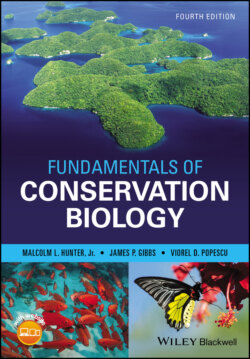Читать книгу Fundamentals of Conservation Biology - Malcolm L. Hunter Jr. - Страница 56
Economic Values Food
ОглавлениеExcept for salt and a few other additives, everything we eat started out as an organism, an element of biodiversity. Often, we do not even recognize all the organisms involved, for example, the enormous array of microorganisms that are essential to the processes by which we produce cheese, yogurt, bread, chocolate, coffee, vanilla, and the various pickled foods and alcoholic beverages. Despite their fundamental role, the instrumental value of species as food is usually considered the domain of agricultural and food scientists rather than conservation biologists, because the vast bulk of our food comes from a relatively small number of domesticated species (Prescott‐Allen and Prescott‐Allen 1990; Khoury et al. 2014). Maintaining the genetic diversity of domestic species is a component of conservation biology as we will see in future chapters, but it is not in the mainstream of conventional conservation biology, which usually focuses on wild species. Nevertheless, there are at least three ways in which conservation biologists who work with wild species are involved with the instrumental value of species as food for people.
First, most domesticated species are closely related to species that are still wild, and these wild relatives are a critical source of genetic material, germplasm, for agricultural breeders trying to improve domesticated species (Khoury et al. 2013). Indeed, in many cases (e.g. pigs, coconuts, and carrots), there are both wild and domesticated populations of the same species. Maintaining viable populations of the wild relatives of crop plants and livestock falls squarely within the purview of mainstream conservation biology, especially if the wild relatives are threatened with extinction. For example, yaks and water buffalos are important livestock in parts of Asia, and the wild populations of both species are in danger of extinction. We lost the wild version of the domestic cow, the auroch, back in 1627 (Szafer 1968). A well‐known example of the potential role of wild relatives is found in the teosintes, wild relatives of corn (or maize) that were thought to be extinct until rediscovered in southern Jalisco, Mexico, in 1978 (Iltis et al. 1979; Hufford et al. 2012). Because teosintes are perennial (regrowing each year from a root system, not new seeds) some of their genetic material, if transferred to corn, could increase its resistance to some diseases and, perhaps, could even enable it to regrow annually without the great expense of tilling and sowing, or the risk of soil erosion.
Second, wild species may be a source of new domesticates in the future. Domestication is almost as old as humanity, and it is still practiced (Meyer et al. 2012). To take two examples, salt‐tolerant plants may be domesticated to use on farmlands degraded by salinization (Rozema et al. 2013) and some of the nearly 2000 species of insects that people consume for food could be prime candidates for domestication (van Huis et al. 2013). Some of the food items that we associate with wild species are already produced primarily using captive populations; for example, most of the venison sold in markets comes from deer farms and most of the salmon and shrimp we eat are raised through aquaculture.
Third, wild plant and animal populations are still major food sources for people (Bharucha and Pretty 2010) (Fig 3.5). In particular, many rural people rely heavily on wild plants and animals (often called bushmeat) for food. It is easy to attribute this practice to the poverty that pervades much of the world. However, people clearly do not consume wild species just out of necessity. Indeed, wild food typically commands a better price than domestic equivalents. For example, in Ghana many wild species, especially grasscutter rats and brush‐tailed porcupines, sell for much more than chicken, pork, or beef (Cowlishaw et al. 2005) and furthermore Ghanaians living abroad will pay extraordinary prices to enjoy wild food from home: for example, they may pay 17–25 times more in New York City than they would pay in Ghana (Brashares et al. 2011). Hunters in the United States may spend the equivalent of hundreds of dollars per kilogram of duck or deer meat once all their investment in equipment, travel, licenses, and lost work is considered, but that misses the point of why they hunt. Of course, game birds and mammals are not the whole story; most of the fish and shellfish (more correctly mollusks and crustaceans) sold in the world – whether dipped from a bucket on the streets of Lagos or wrapped in plastic at a London supermarket – come from wild populations. These issues are particularly important for conservation biologists because: (1) wild populations are often overexploited (Chapter 9, “Overexploitation”); (2) conserving populations requires regulating harvests (Chapter 13, “Managing Populations”); (3) people often pay far more for these species than may seem “rational” and thereby drive exploitation to extreme levels; and (4) maintaining biodiversity requires special consideration for the well‐being of rural people because they share most of the habitat of wild plant and animal populations (Chapters 15, 16, and 17, “Social Factors,” “Economics,” and “Politics and Action”).
Figure 3.5 Although most of our food comes from domestic species, a wide variety of wild species are consumed ranging from the predictable, such as fruits [top], to the rather unusual, such as fruit bat soup in Guam [bottom].
(Malcolm L. Hunter Jr., author) [top]; Courtesy of Merlin D. Tuttle/Bat Conservation International [bottom])
